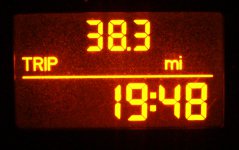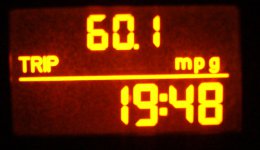Teed off with the drastic mpg hit once the mercury drops below zero, and observing that the front grille is cunningly designed to ensure a continuous blast of icy cold air bathes the radiator & engine compartment, I'm looking at a little 'winter modification'  .
.
Here's a picture of the Mk1 version, and the results of a 40 mile round trip to the shopping centre with a 4 hr stop, so essentially two cold starts & an OAT of around -1C.
Still a significant drop from the summer figures, but the temperature gauge didn't budge even a milllimetre above normal - so the experimentation will continue in the search for better economy.
Here's a picture of the Mk1 version, and the results of a 40 mile round trip to the shopping centre with a 4 hr stop, so essentially two cold starts & an OAT of around -1C.
Still a significant drop from the summer figures, but the temperature gauge didn't budge even a milllimetre above normal - so the experimentation will continue in the search for better economy.




